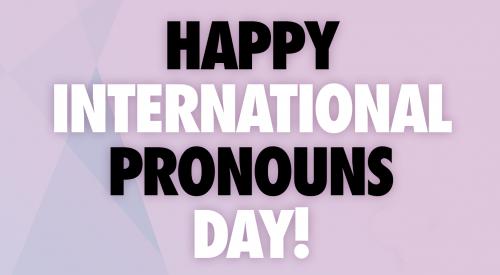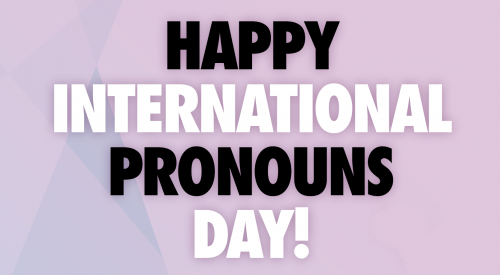
International Pronouns Day

There’s a lot of discussion in the media and online recently about the use of gender pronouns.
Gender pronouns aren’t new though. We use them all the time to identify and refer to someone. Describing people as ‘he’ or ‘she’, groups of people as ‘they’ or ‘them’, as well as inanimate things as ‘it’ is something we all do every day. But that’s just the tip of the iceberg. What some people may not know is there are many valid gender-neutral pronouns that are becoming increasingly common. This would include the use of the singular ‘they’ or ‘ze’. An extensive list of more English gender-neutral pronouns in use are available on the non-binary wiki.
Using gender-neutral pronouns means we don’t associate the person we’re talking about with a specific gender.
Using gender-neutral pronouns means we don’t associate the person we’re talking about with a specific gender. Sex does not predetermine a person’s gender and many people’s gender doesn’t sit comfortably with the sex they were assigned at birth. The easiest way to learn what pronouns someone uses is just to politely ask them (“Hey, what pronouns do you use?”).
It might take some getting used to, but it causes you no harm and using the right pronouns for someone will make them feel acknowledged and valid.
When you’re at work, you can take the lead by saying your pronouns when you introduce yourself at the start of a meeting. Not only will this encourage your colleagues to do the same, but it will help everyone get used to talking about pronouns, which will help trans people feel more comfortable to do the same. Including pronouns in e-mail signatures is another great way to show that you and your organisation is committed to trans equality:
- This helps people respectfully refer to one another.
- It helps staff avoid mistakes, like misgendering someone which can be especially hurtful for trans people, but also embarrassing for non-trans people.
- It can be a great tool for visibly demonstrating trans allyship both internally to your organisation and externally.
If you want to start including pronouns in your e-mail signatures, here’s some practical steps for how you can do this in your workplace:
- Communicate that you are going to start including pronouns in e-mail signatures. Discuss this with your LGBT staff network and determine whether any internal system holders need to be notified or consulted (e.g. Comms team, IT managers). You should have a plan of how best to communicate the benefits of including pronouns in e-mails to internal staff.
- Including pronouns in e-mail signatures should be encouraged, but not be made compulsory as not everyone may feel comfortable sharing their pronouns. There are many different reasons for this and it may be true for both cis and trans staff. (This should also be remembered when verbally introducing pronouns at the start of meetings.)
- You could also include a link to a webpage that gives a definition of pronouns. For example: Pronouns: She/ Her
It’s worth remembering that the phrase ‘preferred pronouns’ is no longer used. Terms like this make it sound like someone’s gender is up for debate. Intentionally using the wrong pronouns for someone repeatedly is a hurtful form of misgendering.
The thing is though, we all make mistakes. So if you get someone’s pronouns wrong please quickly apologise and correct yourself. You can also show solidarity with someone who uses pronouns that others may mistake by politely correcting someone who has used the wrong pronoun even when the person isn’t there.
If you use pronouns that some people may not automatically assume for you please remember to not compromise on them. Ask people to use them. Everyone who cares about you and wants to be part of your life will get there.
Further information can be found on the My Pronouns and International Pronouns Day websites.